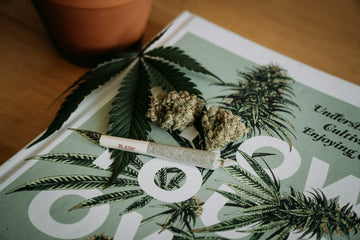Cannabis and Creativity: Exploring the Intersection of Marijuana and Artistic Expression
Throughout history, cannabis has been associated with creativity, inspiration, and artistic expression. From the bohemian poets of the Beat Generation to the psychedelic rock icons of the 1960s, cannabis has played a prominent role in shaping the creative landscape of music, art, literature, and innovation. In this in-depth exploration, we'll delve into the relationship between cannabis and creativity, examining how marijuana influences artistic processes, fosters innovation, and fuels the imagination.
The History of Cannabis and Creativity:
Cannabis has a long and storied history as a creative catalyst, dating back thousands of years to ancient civilizations that revered the plant for its psychoactive and euphoric effects. In cultures such as ancient India, China, and Egypt, cannabis was used in religious ceremonies, spiritual practices, and artistic endeavors, serving as a conduit for inspiration and enlightenment.
In the modern era, cannabis became synonymous with creativity and artistic expression during the counterculture movements of the 20th century. The Beat Generation writers, including Jack Kerouac, Allen Ginsberg, and William S. Burroughs, famously embraced cannabis as a muse for their groundbreaking literary works, challenging conventions and pushing the boundaries of language and form.
Similarly, the psychedelic revolution of the 1960s saw cannabis emerge as a central element of the burgeoning rock and roll music scene, with iconic artists such as The Beatles, Jimi Hendrix, and Bob Dylan incorporating cannabis imagery and themes into their music and lyrics. Cannabis became a symbol of rebellion, freedom, and self-expression, inspiring generations of musicians, artists, and creatives to explore new realms of consciousness and creativity.
The Science of Cannabis and Creativity:
While the relationship between cannabis and creativity has long been observed anecdotally, scientific research on the subject is still relatively limited. However, emerging evidence suggests that cannabis may indeed have the potential to enhance certain aspects of creativity, including divergent thinking, associative thinking, and cognitive flexibility.
Studies have shown that cannabis can alter brain activity and neurotransmitter levels in ways that may facilitate creative thinking and problem-solving. The psychoactive compound THC, in particular, has been shown to stimulate dopamine release in the brain, leading to feelings of euphoria, relaxation, and heightened sensory perception, which may contribute to enhanced creativity and imaginative thinking.
Moreover, cannabis has been found to lower inhibitions and reduce self-censorship, allowing individuals to explore unconventional ideas, perspectives, and artistic expressions without fear of judgment or criticism. This uninhibited state of mind, sometimes referred to as "flow" or "the creative zone," can foster a sense of freedom and spontaneity that is conducive to creative breakthroughs and innovation.
The Influence of Cannabis on Art, Music, and Innovation:
The impact of cannabis on artistic expression and innovation can be observed across a wide range of creative disciplines, including:
1. Visual Arts: Cannabis has inspired countless artists to explore new techniques, styles, and themes in their work, from the surreal paintings of Salvador Dalí to the psychedelic posters of the 1960s counterculture. Cannabis-infused art exhibits, installations, and galleries provide spaces for artists to showcase their work and explore the intersection of cannabis and creativity.
2. Music: Cannabis has long been intertwined with the history of music, influencing genres such as jazz, blues, reggae, and hip-hop. Many musicians credit cannabis with enhancing their creativity, improvisation, and musicality, whether through its relaxing effects, altered perception of sound, or ability to enhance the creative process.
3. Literature: Cannabis has served as a source of inspiration for countless writers, poets, and authors throughout history, from the romantic musings of William Wordsworth to the surreal prose of Hunter S. Thompson. Cannabis-infused literature readings, poetry slams, and spoken word performances provide platforms for writers to share their work and explore cannabis-related themes and narratives.
4. Innovation: Cannabis has sparked innovation and creativity in diverse fields, from technology and design to cuisine and fashion. Entrepreneurs and innovators are leveraging cannabis as a source of inspiration for developing new products, services, and experiences that cater to the growing cannabis market and culture.
Moreover, cannabis legalization has created new opportunities for cannabis entrepreneurs and creatives to participate in the legal cannabis industry, whether through cannabis cultivation, product development, retail, or ancillary services. Cannabis-themed events, festivals, and conferences provide forums for networking, collaboration, and education, fostering a vibrant and inclusive community of cannabis enthusiasts and innovators.
Cannabis has long been celebrated as a catalyst for creativity, inspiration, and artistic expression, influencing art, music, literature, and innovation throughout history. While the scientific understanding of the relationship between cannabis and creativity is still evolving, anecdotal evidence and cultural observations suggest that cannabis can indeed enhance certain aspects of creative thinking, imagination, and problem-solving.
As cannabis legalization continues to spread and stigma diminishes, the intersection of cannabis and creativity is poised to become even more prominent and influential in shaping the cultural landscape. By embracing cannabis as a source of inspiration and exploration, creatives and innovators can tap into new realms of imagination, expression, and innovation, enriching the world with their unique perspectives and contributions.




















